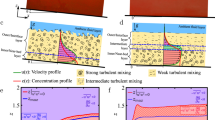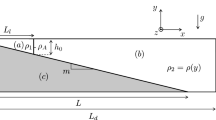Abstract
Turbidity currents are sediment-laden bottom flows in lakes and the ocean that derive their momentum from the force of gravity acting on the sediment held in suspension. These currents are capable of creating highly meandering channels extending over hundreds or thousands of kilometers. The planforms of these channels show a remarkable resemblance to those of meandering rivers. In order to understand the flow of turbidity currents in sinuous channels a simple analysis of steady, streamwise-uniform flow around a bend of low, constant curvature is considered. The analysis is applied to both a river and a channelized turbidity current. In both cases the bed of the channel is sand, and both sand and mud are carried in suspension. The sand requires turbulence in order to be held in suspension, but the mud is sufficiently fine to allow it to be carried as wash load. The flow is assumed to be Froudesubcritical, and in the case of a turbidity current a relatively sharp interface between turbid water and clear water above is assumed. The analysis focuses on the processes that maintain a) the transverse water surface or interfacial slope associated with superelevation around bends and b) the transverse bed slope created by scour on the outside and fill on the inside of bends. In the case of rivers, the processes maintaining these two transverse slopes can be decoupled, allowing for the use of standard formulations. In a turbidity current, however, the processes may be strongly coupled, especially when the concentration of sand in suspension decreases strongly in the vertical.
Access this chapter
Tax calculation will be finalised at checkout
Purchases are for personal use only
Preview
Unable to display preview. Download preview PDF.
Similar content being viewed by others
References
Engelund, F. (1974) Flow and bed topography in channel bends. J. Hydraul. Engrg., 100(11), 1631–1648.
Garcia, M., Parker, G. (1991) Entrainment of bed sediment into suspension. J. Hydraul. Engrg., 117(4), 414–435.
Garcia, M., Parker, G. (1989) Experiments on hydraulic jumps in turbidity currents near a canyon-fan transition. Science, 245, 393–396.
Hay, A.E. (1987) Turbidity currents and submarine channel formation in Rupert inlet, British Columbia, 2, The roles of continuous and surge type flow. J. Geophys. Res., 92, 2883–2900.
Imran, J., Parker, G., Pirmez, C. (1999) A nonlinear model of flow in meandering submarine and subaerial channels. J. Fluid Mech., 400, 295–331.
Johannesson, H., Parker, G. (1989) Secondary flow in a mildly sinuous channel. J. Hydraul. Engrg., 115(3), 289–308.
Komar, P.D. (1977) Computer simulation of turbidity current flow and the study of deep-sea channels. The Sea, 6, 603–621.
Mellor, G., Yamada, T. (1974) A hierarchy of turbulence closure models for planetary boundary layers. J. Atmospheric Sci., 31, 1791–1806.
Parker, G., Andrews, A. (1985) Sorting of bedload sediment by flow in meander bends. Water Res. Res., 21(9), 1361–1373.
Parker, G., Johannesson, H. (1989) Observations on several recent theories of resonance and overdeepening in meandering channels In River Meandering, AGU Water Resources Monograph, Vol. 12 ( S. Ikeda and G. Parker), 379–416.
Parker, G., Imran, J., Pirmez, C. (2000) Long profiles of leveed channels on submarine fans: a first theory. Submitted to J. Sed. Res.
Pirmez, C. (1994) Growth of a Submarine Meandering Channel-levee System on the Amazon Fan. PhD thesis, Columbia University, New York, USA.
Author information
Authors and Affiliations
Editor information
Editors and Affiliations
Rights and permissions
Copyright information
© 2001 Springer-Verlag Berlin Heidelberg
About this chapter
Cite this chapter
Parker, G., Imran, J., Pirmez, C. (2001). Transverse Slope of Bed and Turbid-Clear Water Interface of Channelized Turbidity Currents Flowing around Bends. In: Seminara, G., Blondeaux, P. (eds) River, Coastal and Estuarine Morphodynamics. Springer, Berlin, Heidelberg. https://doi.org/10.1007/978-3-662-04571-8_6
Download citation
DOI: https://doi.org/10.1007/978-3-662-04571-8_6
Publisher Name: Springer, Berlin, Heidelberg
Print ISBN: 978-3-642-07530-8
Online ISBN: 978-3-662-04571-8
eBook Packages: Springer Book Archive




